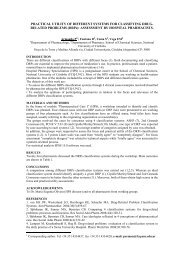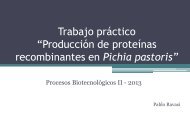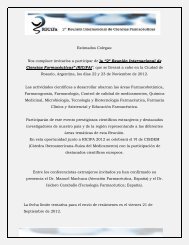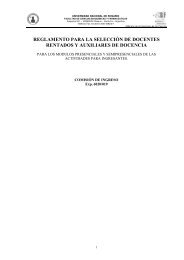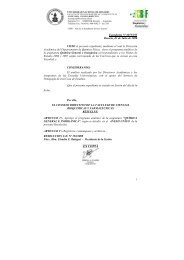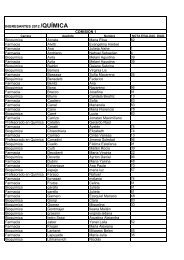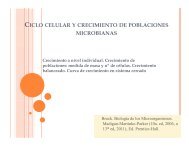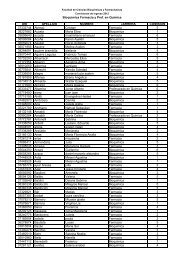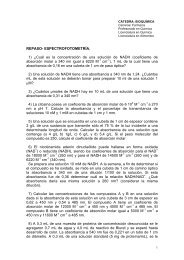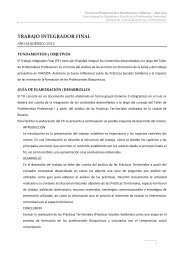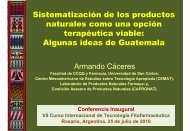PHYTOCHEMICAL ANALYSIS AND TOXICITY STUDY OF Passiflora
PHYTOCHEMICAL ANALYSIS AND TOXICITY STUDY OF Passiflora
PHYTOCHEMICAL ANALYSIS AND TOXICITY STUDY OF Passiflora
You also want an ePaper? Increase the reach of your titles
YUMPU automatically turns print PDFs into web optimized ePapers that Google loves.
<strong>PHYTOCHEMICAL</strong> <strong>ANALYSIS</strong> <strong>AND</strong> <strong>TOXICITY</strong> <strong>STUDY</strong> <strong>OF</strong> <strong>Passiflora</strong> SPECIESFORWARD TO Artemia salina LEACH.Comunello LN* 1 , Duarte MO 1 , Lunardelli S 1 , Gomes MRF 2 , Gnoatto, SCB 1 , Limberger RP 2 , GosmannG 11 Laboratório de Fitoquímica. Faculdade de Farmácia, Universidade Federal do Rio Grande do Sul (UFRGS),Av. Ipiranga, 2752, Porto Alegre, RS, 90610-000, Brazil.2 Laboratório de Toxicologia. Faculdade de Farmácia, Universidade Federal do Rio Grande do Sul (UFRGS),Av. Ipiranga, 2752, Porto Alegre, RS, 90610-000, Brazil.INTRODUCTION<strong>Passiflora</strong> species (<strong>Passiflora</strong>ceae) are native plants from South America that provide appreciated fruitsknown in Brazil as “maracujá” (passion fruit). Some species like P. incarnata, P. alata and P. edulis havebeen traditionally used to treat anxiety and nervousness(1). Antiinflamatory and antioxidant activities are alsoreported for P. alata and P. edulis(2,3).Since ancient times, people have used plants as medicines and this use has great importance, because plantscan provide drugs to widen the therapeutic arsenal. However, many plants are known to be toxic. The UnitedStates FDA has reported cases of toxicity occurring whith <strong>Passiflora</strong> species(1).Artemia salina L. (Artemiidae), the brine shrimp larva, is an invertebrated component of the saline aquaticand marine ecosystems fauna. It has good correlation with “in vivo” test and it is used as an alternativemethod to determine toxicity of chemical and natural products. This method, which determines the LC 50 valueof the active compounds and extracts in saline medium in µg/mL(4), has been used in research on medicinalplants carried out in different countries in order to evaluate toxicity as a screening method mainly for productsof plant origin. In toxicity evaluation of plant extracts by brine shrimp bioassay, an LC 50 value lower than1000 µg/ml is considered bioactive(5).The present study describes the phytochemical study and toxicity assay of P. alata, P. morifolia, P. tricuspis,P. galbana and P. amethystina when submitted to Artemia salina LEACH.MATERIALS <strong>AND</strong> METHODSThe hydroethanolic extract from five <strong>Passiflora</strong> species were prepared using EtOH 40º GL under reflux forone hour. Phytochemical profiles of these species were established by thin-layer chromatography according toBirk(6).For every plant extract, seven concentrations from 1330 to 33 µg/ml (in triplicate) were tested in order todetermine dose-response relationship, and a control group was set with artificial salt water and tween solution.Each test tube with sample contained 10 brine shrimp larvae, including the control group(7). After 24 hours,live larvae were counted and the LC 50 value was estimated using the statistical method of Probits(8).RESULTSFlavonoids and saponins are good chemical markers to provide differentiation between closely relatedspecies. The chemical profile of these extracts was similar to that shown by Birk(6) where the P. alata extractpresents saponins as main metabolites, whereas flavonoids are the major metabolites to the other studiedspecies. The quadranguloside is a saponin previously isolated from the leaves from P. alata and can be usedas chemical market(9). Saponins are metabolites with known biological activity otherwise many saponin aretoxic compounds(10).The hydroethanolic extract from P. alata showed LC 50 = 172.38 µg/mL ± 1.12 and the hydroethanolicextracts of P. tricuspis, P. morifolia, P. galbana and P. amethystina displayed LC 50 > 1330 µg/mL.CONCLUSIONSFive hydroethanolic extracts from <strong>Passiflora</strong> genus were tested in the brine shrimp bioassay and only P. alataextract displayed toxicity (LC 50 < 1000 µg/mL). Considering that P. alata has saponins as major metabolite itis possible that its toxicity is due to this class of compounds. Further studies are needed to evaluate whichcompound present in P.alata extract is responsible for its toxicity.ACKNOWLEDGEMENTS
The authors thank to CNPq, CAPES, FAPERGS and Programa de Pós-Graduação em CiênciasFarmacêuticas/UFRGS for scholarships and financial support. We are grateful to Prof. Gilson R. P. Moreira(Departamento de Zoologia, UFRGS, Brazil) for locating, collecting and identifying the plant material.REFERENCES1 Dhawan K, Kumar S, Sharma A. 2004. <strong>Passiflora</strong>: a review update. Journal of Ethnopharmacology, 94 (1):1-23.2 Vargas AJ, Geremias DS, Provensi G, Fornari PE, Reginatto FH, Gosmann G, Schenkel EP, Fröde TS.2007. <strong>Passiflora</strong> alata and <strong>Passiflora</strong> edulis spray-dried aqueous extracts inhibit inflammation in mousemodel of pleurisy. Fitoterapia, 78 (2): 112-119.3 Rudnicki M, Oliveira MR, Pereira TV, Reginatto FH, Dal-Pizzol F, Moreira JCF. 2007. Antioxidant andantiglycation properties of <strong>Passiflora</strong> alata and <strong>Passiflora</strong> edulis extracts. Food Chemistry, 100 (2): 719-724.4 Massele AY, Nshimo CM. 1995. Brine shrimp bioassay for biological activity of medicinal plants intraditional medicines in Tanzania. East Afr. Med. J. 72(10): 661–3.5 Meyer BN, Ferrigni NR, Putnam JE, Jacobsen LB, Nichols DE, McLaughlin JL 1982. Brine shrimp: Aconvenient general bioassay for active plant constituents. Planta Med 45: 31-34.6 Birk CD, Provensi G, Gosmann G. 2005. TLC Fingerprint of Flavonoids and Saponins from <strong>Passiflora</strong>Species. Journal of Liquid Chromatography & Related Technologiesw, 28: 1–7.7 Parra AL, Yhebra RS, Sardiñas IG, Buela LI. 2001. Comparative study of the assay of Artemia salina L. andthe estimate of the medium lethal dose (LD50 value) in mice, to determine oral acute toxicity of plantextracts. Phytomedicine, 8(5): 395–400.8 Finney D.J.1971. Probits analysis. 3rd ed. Cambridge University Press.9 Reginatto FH, Kauffmann C, Schripsema J, Guillaume D, Gosmann G, and Schenkel EP. 2001. Steroidaland Triterpenoidal Glucosides from <strong>Passiflora</strong> alata. J.Braz. Chem. Soc., 12 (1): 32-36.10 Hostettmann K, Marston A. Saponins. Cambridge, Grã-Bretanha: Cambridge University Press, 1995.*Corresponding author. Tel +55 51 33085516, fax +55 51 33085313;email:maracomunello@hotmail.com



